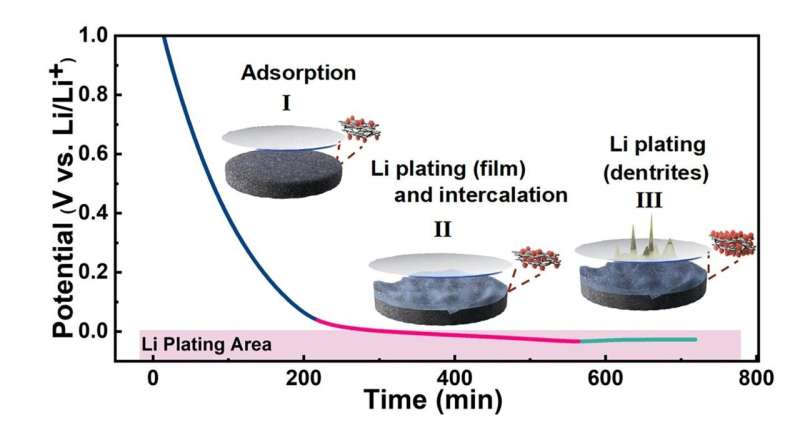
A team of researchers has systematically explored the true reversibility of hard carbon anodes below 0V to identify the lithiation boundary parameters that control the reversible capacity of hard carbon anodes. The lithium storage capacity of hard carbon has been almost doubled. Meanwhile, the lithium storage mechanism of hard carbons is revealed. This work enables insights of the potentially low-voltage performance of hard carbons in lithium-ion batteries.
The team of Chinese researchers from Chinese Academy of Sciences published their work in the journal Particuology , titled “Utilizing the capacity below 0V to maximize lithium storage of hard carbon anodes” on March 17, 2023.
Hard carbons (HCs) have been emerging as promising anode materials for lithium-ion batteries because of their low redox potential and high reversible capacities. HCs consist of plentiful randomly oriented graphene nanosheets as described by the “house of cards” model.
Such a nanoarchitecture endows HCs with large interlayer spacing (0.37–0.4 nm) and abundant amorphous microstructures (defects, short-range microcrystalline, and rich pore structures), which makes more than half of the total capacity of HCs comes from the plateau area (below 0V). Utilizing the plateau capacity of HCs actually enhances the operating voltage as well as the energy density when coupled with cathodes. However, limited by the experience gained from graphite anode, considerable reports on HCs have mainly focused on the lithium storage capacity above 0V.
In order to utilize the lithium storage capacity of HCs below 0V effectively, the research team investigated the following issues: 1) How much capacity is endurable for long-term cycling, 2) What is the kinetic performance of this part of the capacity, 3) What is the lithium storage mechanism of hard carbon?
Next, using the commercial HCs as anodes, the limit of reversible lithium storage capacity of hard carbon was systematically investigated. The cells are lithiated to a series of depths (V-0, C-400, C-500 and C-600). The V-0 exhibits a capacity of 209 mAh g-1 and the voltage of C-400, C-500, C-600 is -0.028, -0.032 and -0.038 V, respectively.
The team observed the surface morphology of electrodes at different lithiation depths. A large number of lithium dendrites appeared on the surface of high lithiation depths (C-500 and C-600). No dendrites were found on the surface of V-0 and C-400.
The research team further tested the rate (25, 50 and 100 mA g-1) and cycle performance of hard carbons at different lithiation depths. The results show that the C-400 exhibits a high average CE of above 99.5% at 50 mA g-1 and operate 172 cycles with a capacity of 80%. Compared with discharging to 0V, C-400 provides a nearly twice reversible capacity. C-500 and C-600 were prone to failure during cycles due to increased cell polarization caused by lithium dendrites.
The research team finally analyzed lithium storage behavior of hard carbon below 0V. The results of characterization and finite element model reveal that the large reversible capacity below 0V of hard carbon anodes is mainly benefited from the dual effect of lithium intercalation and reversible lithium film.
“This work enables insights of the potentially low-voltage performance of hard carbons in lithium-ion batteries,” said Cheng-meng Chen at Chinese Academy of Sciences. Because utilizing the capacity below 0V can help the hard carbon capacity to fully release and increase the anode gram capacity, it can make full cells higher energy density.
“In the next step, our research team will explore more suitable electrolytes for enhancing the performance of hard carbon below 0V,” said Liu. In this way, the researchers might expand the application of hard carbons and also improve the potential for practical applications. “Our ultimate goal is to provide the hard carbon anode for lithium-ion batteries that can be used in a variety of environments with high capacity and long cycle performance,” said Liu.
More information:
Qianlei Liu et al, Utilizing the capacity below 0 V to maximize lithium storage of hard carbon anodes, Particuology (2023). DOI: 10.1016/j.partic.2023.03.001
Provided by
Particuology
Citation:
Utilizing the capacity below 0V to maximize lithium storage of hard carbon anodes (2023, April 7)
retrieved 7 April 2023
from https://techxplore.com/news/2023-04-capacity-0v-maximize-lithium-storage.html
This document is subject to copyright. Apart from any fair dealing for the purpose of private study or research, no
part may be reproduced without the written permission. The content is provided for information purposes only.
Stay connected with us on social media platform for instant update click here to join our Twitter, & Facebook
We are now on Telegram. Click here to join our channel (@TechiUpdate) and stay updated with the latest Technology headlines.
For all the latest Technology News Click Here
For the latest news and updates, follow us on Google News.
